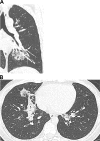Approach to Peribronchovascular Disease on CT
- PMID: 31200868
- PMCID: PMC7126938
- DOI: 10.1053/j.sult.2018.12.002
Approach to Peribronchovascular Disease on CT
Abstract
Diseases that are predominantly peribronchovascular in distribution on computed tomography by definition involve the bronchi, adjacent vasculature, and associated lymphatics involving the central or axial lung interstitium. An understanding of diseases that can present with focal peribronchovascular findings is useful for establishing diagnoses and guiding patient management. This review will cover clinical and imaging features that may assist in differentiating amongst the various causes of primarily peribronchovascular disease.
Copyright © 2018 Elsevier Inc. All rights reserved.
Figures












Similar articles
-
Diseases Involving the Lung Peribronchovascular Region: A CT Imaging Pathologic Classification.Chest. 2024 Oct;166(4):802-820. doi: 10.1016/j.chest.2024.05.033. Epub 2024 Jun 22. Chest. 2024. PMID: 38909953 Review.
-
Diseases affecting the peribronchovascular interstitium: CT findings and pathologic correlation.Curr Probl Diagn Radiol. 2005 Mar-Apr;34(2):63-75. doi: 10.1067/j.cpradiol.2004.12.002. Curr Probl Diagn Radiol. 2005. PMID: 15753880
-
Peribronchovascular interstitium of the pulmonary hilum: normal and abnormal findings on thin-section electron-beam CT.AJR Am J Roentgenol. 1996 Feb;166(2):309-12. doi: 10.2214/ajr.166.2.8553936. AJR Am J Roentgenol. 1996. PMID: 8553936
-
[Bronchial carcinoid studied by spiral computed tomography with 3-dimensional reconstructions and virtual endoscopy. A case].Radiol Med. 2000 Jul-Aug;100(1-2):71-3. Radiol Med. 2000. PMID: 11109458 Review. Italian. No abstract available.
-
Metastatic Endobronchial Ameloblastoma.J Bronchology Interv Pulmonol. 2017 Oct;24(4):307-309. doi: 10.1097/LBR.0000000000000365. J Bronchology Interv Pulmonol. 2017. PMID: 28169911 No abstract available.
Cited by
-
Ocrelizumab-induced organizing pneumonia in multiple sclerosis: case report and literature review.Arch Clin Cases. 2024 Jul 16;11(2):69-73. doi: 10.22551/2024.43.1102.10291. eCollection 2024. Arch Clin Cases. 2024. PMID: 39015300 Free PMC article.
-
Peribronchovascular thickening.J Bras Pneumol. 2022 Mar 14;48(1):e20220024. doi: 10.36416/1806-3756/e20220024. J Bras Pneumol. 2022. PMID: 35293490 Free PMC article. No abstract available.
-
Algorithmic Approach to the Diagnosis of Organizing Pneumonia: A Correlation of Clinical, Radiologic, and Pathologic Features.Chest. 2022 Jul;162(1):156-178. doi: 10.1016/j.chest.2021.12.659. Epub 2022 Jan 14. Chest. 2022. PMID: 35038455 Free PMC article. Review.
-
Risk factors for bronchiectasis in patients with chronic obstructive pulmonary disease: a systematic review and meta-analysis.Clinics (Sao Paulo). 2021 Apr 16;76:e2420. doi: 10.6061/clinics/2021/e2420. eCollection 2021. Clinics (Sao Paulo). 2021. PMID: 33886788 Free PMC article.
-
Navigating the labyrinth: Phenotypes of IgG4-related disease.J Postgrad Med. 2025 Jan 1;71(1):45-48. doi: 10.4103/jpgm.jpgm_757_24. Epub 2025 Mar 14. J Postgrad Med. 2025. PMID: 40085066 Free PMC article.
References
-
- Castaner E., Gallardo X., Pallardo Y. Diseases affecting the peribronchovascular interstitium: CT findings and pathologic correlation. Curr Probl Diagn Radiol. 2005;34:63–75. - PubMed
-
- Do K.H., Lee J.S., Seo J.B. Pulmonary parenchymal involvement of low-grade lymphoproliferative disorders. J Comput Assist Tomogr. 2005;29:825–830. - PubMed
-
- Webb W.R., Muller N.L., Naidich D.P. Lippincott Williams & Wilkins; Philadelphia, PA: 2001. High-resolution CT of the Lung.
-
- Lynch R.C., Gratzinger D., Advani R.H. Clinical impact of the 2016 update to the WHO lymphoma classification. Curr Treat Options Oncol. 2017;18:45. - PubMed

